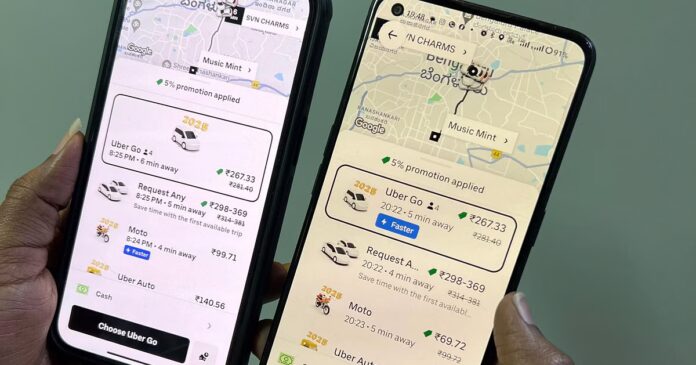Ola Uber Price Disparity has ignited a major debate, leading to a government investigation into alleged unfair pricing practices by popular ride-hailing services Ola, Uber, and Rapido. The Central Consumer Protection Authority (CCPA) is probing claims that these companies charge different fares for the same rides based on whether users are on Android or iOS devices. The allegations have raised serious concerns about discriminatory pricing and unethical business practices.
What Is Ola Uber Price Disparity?
The term refers to the reported difference in fares charged by ride-hailing platforms for identical routes and rides, solely based on the operating system of the user’s device. Numerous reports from consumers reveal that iOS users frequently pay more than their Android counterparts for the same trips.
This disparity has led to outrage among consumers, who see it as a breach of trust. Union Minister Pralhad Joshi termed the practice “unfair trade,” prompting immediate government action to investigate these claims and ensure fair treatment of consumers.
How Ride-Hailing Platforms Determine Prices?
Ride-hailing platforms rely on dynamic pricing models driven by sophisticated algorithms. These algorithms factor in:
- Demand And Supply: Prices increase during peak hours or in high-demand areas.
- Distance And Time: Longer distances and traffic congestion contribute to higher fares.
- Local Conditions: Fuel costs, taxes, and driver availability impact overall pricing.
While dynamic pricing is widely accepted, allegations of system-based price discrimination suggest another layer of pricing logic. Experts believe that user data, including device type, might play a role in tailoring fares.
Why Are iOS Users Reportedly Paying More?
There are several theories as to why iOS users might be charged higher fares:
- Perceived Affluence: iOS devices are generally associated with higher-income users, leading companies to assume greater willingness to pay.
- Algorithm Bias: Pricing algorithms may factor in user data that inadvertently discriminates against certain groups.
- Platform Costs: App store fees and other operational costs for iOS apps might influence pricing strategies.
Although these theories remain unverified, they highlight the opaque nature of algorithm-driven pricing.
Consumer Reaction To Price Discrimination
The allegations have sparked widespread criticism, with many consumers sharing their experiences on social media. iOS users have voiced frustration over being unfairly targeted, while Android users have expressed concern about potential future implications.
- Loss Of Trust: Consumers feel betrayed by platforms they depend on for reliable transportation.
- Demand For Transparency: There is a growing call for clearer explanations of how fares are calculated.
- Boycott Movements: Some consumers have threatened to switch to alternative platforms until the issue is resolved.
Government’s Role And Ongoing Investigation
The Indian government, through the CCPA, has launched a comprehensive probe to address these concerns. The investigation aims to:
- Analyze pricing algorithms used by Ola, Uber, and Rapido.
- Identify patterns of disparity between Android and iOS users.
- Determine whether these practices violate consumer protection laws.
The investigation also seeks to establish whether pricing disparities stem from deliberate actions or inadvertent biases in algorithm design.
Implications For Ride-Hailing Platforms
This investigation could have far-reaching consequences for the ride-hailing industry:
- Regulatory Reforms: Stricter guidelines for pricing algorithms may be introduced.
- Legal Challenges: Companies could face lawsuits or penalties if found guilty of discriminatory practices.
- Competitive Advantage: Smaller competitors may gain an edge by emphasizing fair and transparent pricing.
Global Context Of Algorithmic Pricing
This issue is not unique to India. Globally, tech companies have faced scrutiny for discriminatory pricing practices:
- In 2018, Uber was accused of charging higher fares for women compared to men in certain regions.
- Amazon and other e-commerce platforms have faced backlash for dynamic pricing strategies targeting specific demographics.
These examples underscore the importance of regulating algorithm-driven pricing to ensure fairness and accountability.
What Consumers Can Do?
While the investigation is ongoing, consumers can take steps to protect themselves:
- Compare Prices: Use multiple ride-hailing platforms to identify potential disparities.
- Report Issues: File complaints with consumer protection authorities if discrepancies are observed.
- Advocate For Transparency: Demand clear explanations of fare calculations from service providers.
Ola, Uber, And Rapido’s Response
The companies under investigation have pledged full cooperation with the government inquiry. Ola and Uber have defended their pricing models in the past, citing market-driven factors. However, they have yet to address specific concerns about operating system-based pricing disparities.
The Need For Fairness In Digital Commerce
As technology continues to shape everyday life, ensuring fairness in digital transactions becomes increasingly important. This investigation into Ola Uber Price Disparity highlights the need for greater oversight and accountability in the tech industry.
The outcome of the government probe will likely set a precedent for how ride-hailing platforms and other tech companies operate in India and beyond. With consumer rights at the forefront, this case could pave the way for more transparent and equitable practices in the digital economy.




